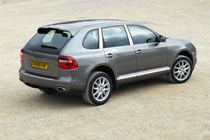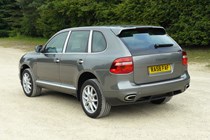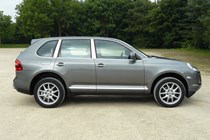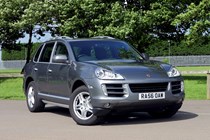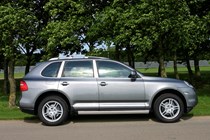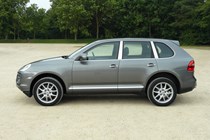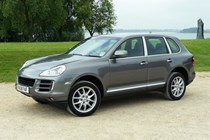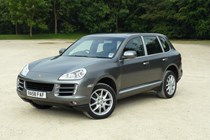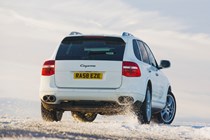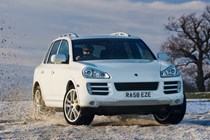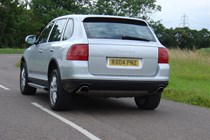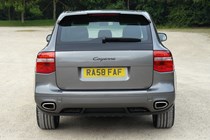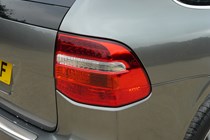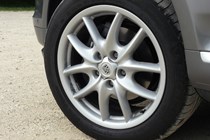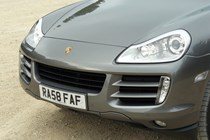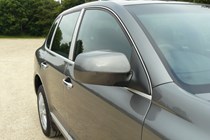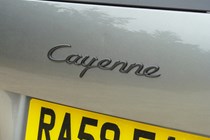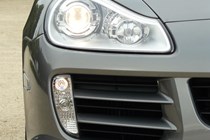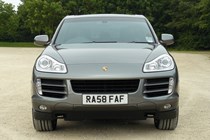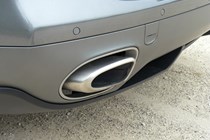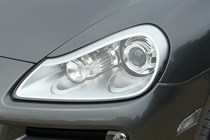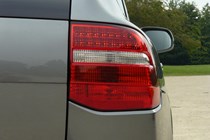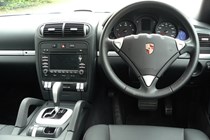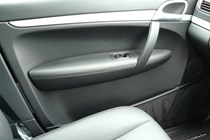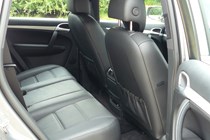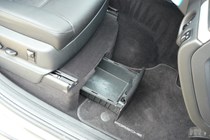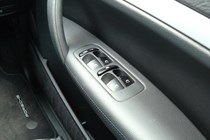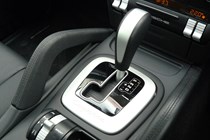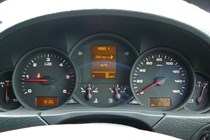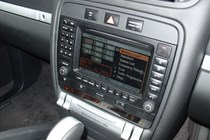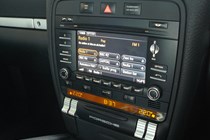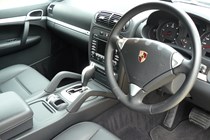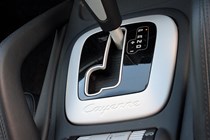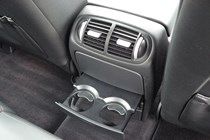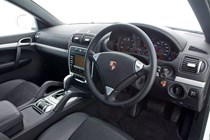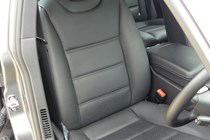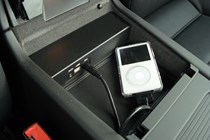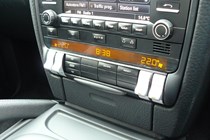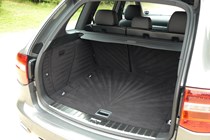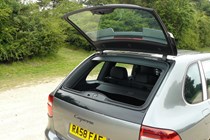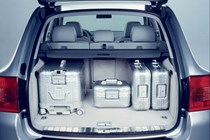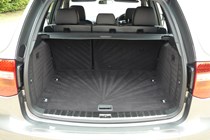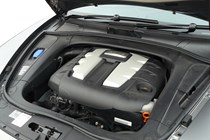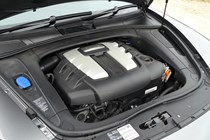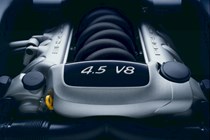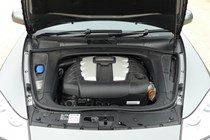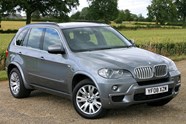
Porsche Cayenne Estate (2003-2009) review
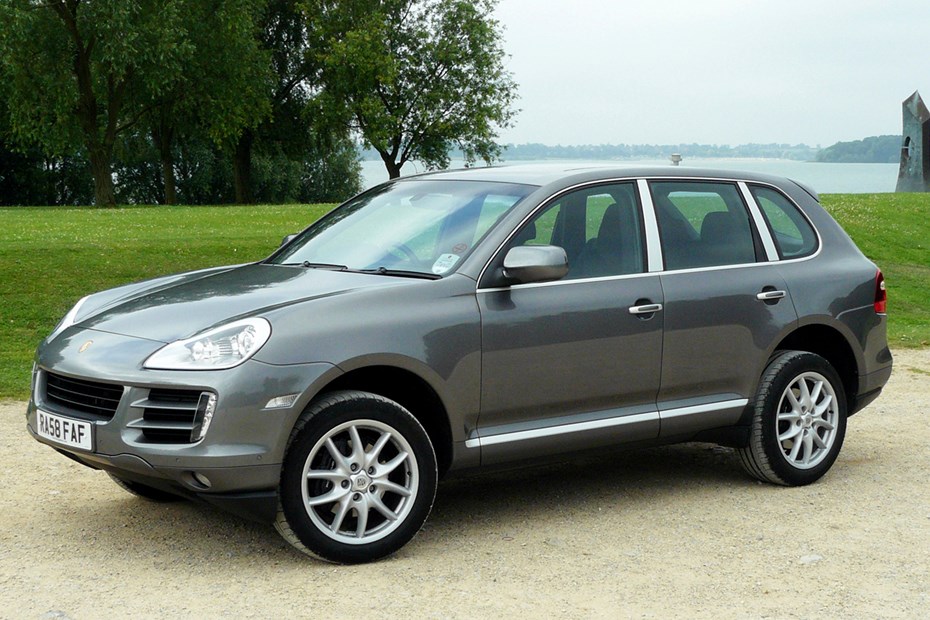
At a glance
| Price new | £35,598 - £91,678 |
|---|---|
| Used prices | £1,059 - £7,589 |
| Road tax cost | £430 - £760 |
| Insurance group | 44 - 50 |
Get an insurance quote with

|
|
| Fuel economy | Not tested to latest standards |
| Range | 374 - 660 miles |
| Number of doors | 5 |
| View full specs for a specific version | |
Available fuel types
Petrol
Diesel
Pros & cons
- Porsche quality – and performance with V8 and Turbo
- Car-like handling
- Capable off-road with the right tyres
- Ungainly styling for a Porsche
- Expensive running costs and repairs
- Firm ride
Porsche Cayenne (03-09) rivals
Overview
At the start of the 21st century two competing factions went to war, and it was all about oil. No, not that war – the war on emissions. On the one hand we had GM and Toyota experimenting with electric cars and introducing hybrids, and on the other hand we had the rise of the SUV. Porsche, for years defined by sports cars, introduced the Cayenne SUV, which revolutionised the firm – and today it’s one of the best used cars for less than £5,000.
The original Porsche Cayenne is closely related to the Volkswagen Touareg, but has a distinctive, luxurious interior and a unique-to-Porsche V8 engine (as well as the modified Volkswagen VR6 used in the 3.2/3.6). This isn’t unusual for Porsche by any means – from the first 356 to the latest Taycan electric GT, VW platform and technology sharing has been a big part of the sports-car brand’s survival (and prosperity).
As the 914 and 924 revealed, British car snobbery can be a little unkind if there’s not quite enough Porsche content, however.
Now over twenty years old for the earliest examples, the Porsche Cayenne Mk1 (Typ 955, or 957 post-facelift) can be found advertised for as little as £3,000 even from dealers, and even less for road-legal, but not necessarily road-worthy examples in the usual dark corners of Facebook marketplace and eBay.
It is extremely tempting for used car buyers – a roomy, practical SUV with Porsche style (the simple curves have not aged badly, given the overblown details of modern SUVs) and theoretically, performance, for less than the deposit on a new supermini? Aside from the fuel economy, what’s the catch?
Is a cheap Porsche Cayenne worth buying?
Choosing a Cayenne as a cheap car only makes sense if you aren’t looking for cheap motoring. The appeal is in getting a Porsche, a V8 engine, some luxury trim and a capable 4x4 for very little outlay – it will still cost a lot of money to maintain and run.
It’s a great way to see the last days of petrol car dominance out in style, a future classic, and ‘cheap, ridiculously powerful old 4x4’ is a piece of car culture that won’t be around for much longer. So, our first question is ‘do you plan on maintaining it yourself?’. If you’re not confident with a code reader, multi-meter and set of spanners, steer clear. Or get ready to learn some new skills.
Labour rates and parts prices, particularly for new genuine parts and diagnostic of electrical and complex running faults, will turn a cheap Cayenne into a money pit overnight. The bargain basement Porsche only makes sense if you already have some skill and time to DIY your car maintenance, and ideally space to keep the car covered and dry.
If you fit the profile, however, you’re in for some good news – the Cayenne has the highest initial build quality of any of the 1998-2010 luxury SUVs you’ll find except, perhaps, Lexus. That doesn’t mean things last forever, or never go wrong; rather, if you love the car and are prepared to fix wear and tear, it’ll reward you by staying sharp and presentable, and just as luxurious inside.
The cheapest Cayennes you find will usually be the 3.2-litre V6, powered by a Volkswagen VR6 engine. Capturing the spirit of the Audi/VW powered 924 perfectly, they are all show and little go, but owners report good overall reliability. Barely able to beat a Dacia Duster to 62mph (around 10 seconds before the ravages of time), the V6 Cayenne is fine if you must have that style; the performance and economy is dire.
We’d recommend looking at a Turbo, Turbo S, or 4.5 V8 S, based on the best model you can find for the budget rather than the performance. The Turbo is the point where the Cayenne’s performance begins to match the brand, the Turbo S is impressive but begins to introduce more expensive consumables, particularly around the braking system, the V8 S is the cheapest but also the least reliable, surprisingly.
How much should I spend on a Cayenne to get a good one?
We opened with £3,000, and that’s because for years, it has been the point where used Cayennes show up in the cheap-car lottery. In 2019 that might even have secured a good example, but post-inflation, pandemic and cost-of-living pressures you should expect to spend £5,000 to get a Cayenne that will look good and have a good chance of reaching the next MOT with just routine, required maintenance.
That encompasses some low mileage, historied trade sales and private examples, generally keeps the cars in the pre-2006 lower tax band, and is still less than the example deposits on many small new cars on PCP. Some dealer examples may even have a three month warranty at this price, whereas the cheapest ones are usually sold as seen (which, legal or not, is a hassle you don’t need if it goes wrong the moment it leaves the forecourt).
Even at 19mpg, when a new Ford Fiesta costs more than £350 per month plus a £5,000 first payment, that Cayenne looks like good value for drivers looking for badge prestige and luxury.
Don’t be tempted by a cheaper example with the logic that the faults could cost less than the savings to fix – there will always be more to do. One £3500 model we enquired about, with a very honest description, would have needed £1500 of specialist parts & labour to fix any one of the six entirely reasonable issues listed, all of which were fairly routine problems you’d find on any 20 year old luxury car.
Crucially, the MOT history and overall condition suggested the repairs would be worthwhile – but not right at the start, only if they arose on a car you already owned and trusted.
Buying a Porsche Cayenne Mk1: known problems and common faults
Before embarking on a Cayenne purchase, put some effort in. Look around the country for the best, don’t hope for a great one on your doorstep, and try and view a couple before deciding to make sure the steering weight and size of car is what you want.
Get insurance quotes for your postcode, and on any car you’re going to view check the MOT history online (if the seller has hidden the registration, ask for it). Like many high-end, luxury cars, Porsche Cayennes do not like being left parked up outdoors for long periods – if there’s a large gap in MOTs, or long period of very low mileages, be extra careful checking all the electrical systems.
1. 4.5 V8 engine – Cayenne S
Listen for an irregular tapping or light knocking noise and look for smoke as a starting point. Bore wear, unaffected by servicing or a particular age, can affect this engine. Once it has a sign of the issue, failure could be imminent – and will write the car off at this age unless you’re a very skilled and determined DIYer.
Plastic cooling pipes can fail – this applies to the Turbo models as well. Upgraded metal parts are inexpensive and easy to fit, and you’ll be forced to do a coolant change as well which is often neglected. Change the water pump at the same time if it hasn’t been done recently.
Service parts are not particularly expensive and the engines can last 200,000 miles with ease, but the cylinder lining issue (historically usually related to cheaper fuels) could strike equally at 70,000 or 170,000. That’s the risk you take.
2. 3.2 and 3.6 V6 engine – Cayenne, but not spicy
In the Porsche, VW’s VR6 engine is generally reliable if maintained well. Electronic sensors, coil packs and gaskets if servicing has been neglected are the main failure points and it seems Porsche owners, keen to maintain the car’s value, may have paid for more diligent servicing than the same engine in a VW.
Facelift models use the 3.6-litre version of the engine. Ironically, the Porsche can be found for less than the similarly-engined Volkswagen R or upmarket Audi models. That’s probably because even ignoring the Porsche badge it is not fast, or exciting, or very economical. We’d be particularly wary of one used for towing. It’s not even cheap to tax, the post-2007 3.6 costing the full rate and thus, the same as a Turbo S in VED.
The strongest argument in favour of the V6 is that it was the cheapest model new, is plentiful, and you might get a nicer (and simpler to maintain) Cayenne-shaped vehicle and a Porsche badge on your driveway for a good price.
3. Gearbox and transmission
All Cayenne Mk1s are all-wheel drive, with a low-range mode for crawling and electronic traction control. A locking centre differential is present on most (it is variable locking in normal modes, engaging all-wheel drive as required); a lockable rear differential is an option but the switch features all positions whether it’s present or not. You can test low range easily, but to test the centre differential lock you will need to find a loose surface – don’t engage it on tarmac and drive around bends.
The Tiptronic automatic is a relatively straightforward auto with override, and the usual caveats of oil changes, filter changes and uprated oil coolers for extended towing apply. If it slips or fails to engage drive under hard acceleration, expect to replace or rebuild.
A manual option was available, but it’s rare at the cheap end of the market. The V6 is markedly quicker as a manual.
The all-wheel drive system is generally reliable, and shares many components with the Touareg and other Volkswagen group cars. A common failure is the centre prop bearing which will cause vibration and rumbling when it begins to fail.
4. Electronics and wiring
Most components in the Cayenne are well made and will last for decades, but the electrical system is vulnerable to another failing. Some might argue it’s down to maintenance, others poor design, but the Porsche’s drain holes block if they are not cleaned regularly and this means the sills, inside the body and finally the wriing can get saturated with water.
Battery drains, odd lighting behaviour, failure to lock or unlock doors, and general ‘haunted car’ shenanigans can ensue as well as the more obvious ‘car won’t work’ failures. Draining the water and drying the car can help, but you really need to get every connector, every joint, and make sure it’s clean and secure. This will cost thousands in a specialist or dealer, so only take on a Cayenne with electrical issues if you have a garage to work in, experience of modern vehicle electrical systems, and a great deal of patience.
Draining the water is relatively straightforward, and you should check the drains – sunroof and bodywork – on all cars regularly. The Cayenne’s trouble point is inside the front wing near the A-pillar. Once water damage has struck the ECUs and wiring looms, eradicating it could take weeks of trial and error.
5. Suspension and steering
You will find the V8 Cayenne S with either air suspension or steel springs, the latter being the smart choice for budget buying. Air is standard on Turbo and Turbo S: it’s worth having for the best ride quality but leaks and failed compressors are the norm rather than the exception on cheap cars. Some people live with the slow drop in height, but the compressor wears out over time so a few months or years of compensating for lost pressure will eventually add to the repair bill.
Suspension airbags can be expensive, particularly the rear ones. Inexpert garages can damage the air suspension too, by not setting it to workshop mode (regulation off – hold the up position on the control until it beeps) or letting the car idle and inflate before fully lowering it off a jack or lift.
On the examples we tried, the steering felt heavier than you would expect of a modern luxury car. This may be down to tyre choice, age or just how it’s set up – without a new one to compare it to, just make sure it feels right when driving at speed or parking.
6. Gadgets and spec – investment, or cheap car?
Cayennes appeal to enthusiasts and owners looking for bling on a budget – both groups are inclined to mess with the kit, look for upgrades, and take advantage of the cheap used parts you can find on eBay. When buying a Cayenne for the long-term, we’d double-check the build sheet agains the options on the car, make sure it has two keys, all accessories and documents.
Most cheap Cayennes are grey or black with grey or black interiors and largely plastic trims. Anything that has an unusual colour, trim or accessory set will attract a premium, but for resale it has to be original.
On the other hand if you just want a cheap toy to indulge in a silly 4x4 for winter or grab that chance for a Porsche for little cash, just buy on condition as you see it. From what we’ve seen Cayenne interiors are remarkably resilient compared with Land Rover/Range Rover or Mercedes equivalents, so you needn’t be afraid of making your SUV work hard as a practical hauler.
7. Wheels and tyres – beware the bling
As mentioned above, wheels and tyres matter. This is a heavy, fast vehicle, but for looks and some of the prestige of newer models many owners fit aftermarket 20-22” wheels on budget tyres. It looks good outside the kebab shop, but if you want to enjoy your Cayenne properly on typical British roads, we’d go for the smaller original wheels where possible and make sure they have good, high-end brand tyres of the correct speed rating.
Winter tyres will make all the difference for snow, so if you do want bigger rims keep the old ones for cold-weather capability.
How to run a Porsche Cayenne on a budget – quick tips
Refer back to the section above regarding a cheap Cayenne – start by learning about car servicing. Because the Cayenne is well made and rather large, most parts are easily accessed (though you will need very high quality jacks and supports for more advanced jobs. Don’t cut corners on safety) and you can save money while prolonging the life of your car by doing basic fluid changes and routine services more frequently, yourself.
Join an enthusiast forum or owners’ club to get advice and access to classifieds. It’s a good idea to do this before buying a car, though you won’t find the cheapest examples for same you may find the most cherished, for better prices than a dealer would ask.
Even if you don’t do the practical work yourself, understanding what needs attention, when, and how to look for issues before they become problems will pay off in the end.
Oil changes every year or 6,000 miles, done yourself, are much better value than waiting for the service light and paying a garage – and the engine will thank you. Getting a trusted local specialist to change transmission fluid and filters before problems arise is also a good move. Most electronic faults start with making sure connections are clean and secure, and learning some basic trim removal and replacement skills will keep the refined, luxury interior in good order.
Second hand parts are plentiful, and often cheap. Research your model’s original equipment and keep an eye out for matching pieces, and if you have room keep a few cheap, opportune finds in hand (you can always resell if you don’t use them).
Don’t skimp on brand for fuel or tyres. Some 4.5 S models used a cylinder lining that degraded with cheaper fuels (Turbo models use a different type) and this can cause sudden, catastrophic failure of the engine. Now you know where all those cheap used parts are coming from.
Is it worth getting a Cayenne with LPG?
Many cars have been modified for LPG due to the high running costs. There is nothing inherently wrong with a good LPG installation (it may even help prolong the life of the engine), but many cheaper examples have things like the old ‘propane tank in the boot across the back of the seats’ approach, with crudely-cut trim and bodywork holes.
Not only do such conversions scream ‘doing it on the cheap’ – not a way to enjoy any Porsche – they’re often on low mileage cars where you question the cost/benefit; has the owner decided to sell up because the LPG doesn’t work properly? The worst rust we’ve seen on any Cayenne while researching this article was around an LPG filler hacked into the side.
Find one with a proper underbody or donut tank, a clean install and a high-end system – particularly if it’s on a high-mileage car – and it should work out well if you live near an LPG station.
Still tempted by a Porsche for peanuts? Read the rest of the review to see how we rated it when it was a new.
As with all used purchases, do remember to get a car history check. It might just save you from an unpleasant surprise later down the line. Also, don’t forget you can use our valuation tool to get an idea of how much you should be paying for a car. You can also check our reviews section for more information about the cars you are interested in.




